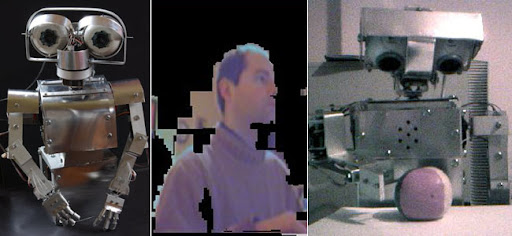Bob Mottram, crafty fellow
[Audio Version]
I sometimes use my rickety platform here to review new technologies and web sites, but I haven't done enough to give kudos to the unusual people in AI that dot the world and sometimes find their way online. Bob Mottram is one such person that deserves mention.
 Who is Bob Mottram? He's a 33-ish year old British programmer who has found a keen interest in the field of Artificial Intelligence. He seems to be fairly well read on a variety of studies and technologies that are around. What starts to make him stand out is his active participation in the efforts. Like me, he finds that many of the documents out there that describe AI technologies sound tantalizingly detailed, but are actually very opaque when it comes to the details. Unlike most, however, he takes this simply as a challenge to surpass. He designs and codes and experiments until his results start to look like what is described in the literature.
Who is Bob Mottram? He's a 33-ish year old British programmer who has found a keen interest in the field of Artificial Intelligence. He seems to be fairly well read on a variety of studies and technologies that are around. What starts to make him stand out is his active participation in the efforts. Like me, he finds that many of the documents out there that describe AI technologies sound tantalizingly detailed, but are actually very opaque when it comes to the details. Unlike most, however, he takes this simply as a challenge to surpass. He designs and codes and experiments until his results start to look like what is described in the literature.
The next thing that sets Mottram apart is his willingness to step outside the bounds of simply duplicating other people's work. He applies what he learns and hypothesizes about new ways of solving problems, going so far as to envision tackling the high goal of duplicating the inner workings of the brain in software.
Perhaps what really sets Bob Mottram apart, for me, is his willingness to take his work public. His web site (http://sluggish.uni.cc/) is chock full not only of listings of projects he's worked on, but also keen and easy-to-read insights on what he's learned along the way. He also has the venerable habit of peppering his material with links to related content as background and credit.
Mottram's web site has a fascinating smattering of content about various projects he's worked on. The one that first got my attention was his "Rodney" project. Named after Rodney Brooks, creator of the famous Genghis and Cog robots, Rodney is Mottram's low-budget answer to Cog.

Through a set of successive iterations, Mottram had built Rodney to be ever more sophisticated as a piece of hardware, but more importantly, had continued to experiment with a variety of different sensing and control techniques. His project web site documents many of these experiments. He also makes available much of his source code.
What got my attention in the first place was his page on Rodney's vision system. Do a Google search on "robot stereo vision" or using a variety of related terms and you're likely to find Bob Mottram's page on his research. It's not necessarily that his work is really groundbreaking; it's just that he's one of the only people to really document his work. As I was doing background research for an upcoming introduction to machine vision, I found his site over and over again in relation to certain kinds of techniques he's implemented and documented.
Seeing the general utility of the vision system he was creating for Rodney, Mottram moved on to his Sentience project. The primary goal was to extract and make open-source a software component that can use input from two cameras to construct a 3D model of what the eyes see.

Mottram's web site includes plenty of other interesting and arcane experiments. Many are whimsical applications of his experiments with stereo vision and detecting motion and change in images, like a Space Invader type game where the player's image is transposed with the aliens or a program that detects people moving within a stationary webcam's field of view. Some delve deeper into new research, like his face detection and imitation work or his Robocore project.
Finally, Mottram has his very own blog. It's not specifically for AI, but does include various insights into the subject from time to time.
In all, I give Bob Mottram a good heap of credit for being a crafty fellow who is sincere in his belief in and pursuit of the goals of Artificial Intelligence. And he gets major kudos for sharing his work online for geeks like me. Do check out his web site.
I sometimes use my rickety platform here to review new technologies and web sites, but I haven't done enough to give kudos to the unusual people in AI that dot the world and sometimes find their way online. Bob Mottram is one such person that deserves mention.
 Who is Bob Mottram? He's a 33-ish year old British programmer who has found a keen interest in the field of Artificial Intelligence. He seems to be fairly well read on a variety of studies and technologies that are around. What starts to make him stand out is his active participation in the efforts. Like me, he finds that many of the documents out there that describe AI technologies sound tantalizingly detailed, but are actually very opaque when it comes to the details. Unlike most, however, he takes this simply as a challenge to surpass. He designs and codes and experiments until his results start to look like what is described in the literature.
Who is Bob Mottram? He's a 33-ish year old British programmer who has found a keen interest in the field of Artificial Intelligence. He seems to be fairly well read on a variety of studies and technologies that are around. What starts to make him stand out is his active participation in the efforts. Like me, he finds that many of the documents out there that describe AI technologies sound tantalizingly detailed, but are actually very opaque when it comes to the details. Unlike most, however, he takes this simply as a challenge to surpass. He designs and codes and experiments until his results start to look like what is described in the literature. The next thing that sets Mottram apart is his willingness to step outside the bounds of simply duplicating other people's work. He applies what he learns and hypothesizes about new ways of solving problems, going so far as to envision tackling the high goal of duplicating the inner workings of the brain in software.
Perhaps what really sets Bob Mottram apart, for me, is his willingness to take his work public. His web site (http://sluggish.uni.cc/) is chock full not only of listings of projects he's worked on, but also keen and easy-to-read insights on what he's learned along the way. He also has the venerable habit of peppering his material with links to related content as background and credit.
Mottram's web site has a fascinating smattering of content about various projects he's worked on. The one that first got my attention was his "Rodney" project. Named after Rodney Brooks, creator of the famous Genghis and Cog robots, Rodney is Mottram's low-budget answer to Cog.

Through a set of successive iterations, Mottram had built Rodney to be ever more sophisticated as a piece of hardware, but more importantly, had continued to experiment with a variety of different sensing and control techniques. His project web site documents many of these experiments. He also makes available much of his source code.
What got my attention in the first place was his page on Rodney's vision system. Do a Google search on "robot stereo vision" or using a variety of related terms and you're likely to find Bob Mottram's page on his research. It's not necessarily that his work is really groundbreaking; it's just that he's one of the only people to really document his work. As I was doing background research for an upcoming introduction to machine vision, I found his site over and over again in relation to certain kinds of techniques he's implemented and documented.
Seeing the general utility of the vision system he was creating for Rodney, Mottram moved on to his Sentience project. The primary goal was to extract and make open-source a software component that can use input from two cameras to construct a 3D model of what the eyes see.

Mottram's web site includes plenty of other interesting and arcane experiments. Many are whimsical applications of his experiments with stereo vision and detecting motion and change in images, like a Space Invader type game where the player's image is transposed with the aliens or a program that detects people moving within a stationary webcam's field of view. Some delve deeper into new research, like his face detection and imitation work or his Robocore project.
Finally, Mottram has his very own blog. It's not specifically for AI, but does include various insights into the subject from time to time.
In all, I give Bob Mottram a good heap of credit for being a crafty fellow who is sincere in his belief in and pursuit of the goals of Artificial Intelligence. And he gets major kudos for sharing his work online for geeks like me. Do check out his web site.

Comments
Post a Comment